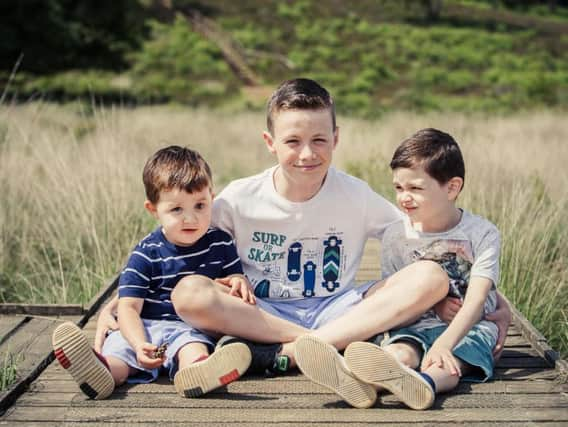Three Wisbech brothers each given prestigious award in national charity first after family's battle with rare cancer


In August 2017 Logan Brown from Wisbech St Mary in Cambridgeshire was diagnosed with retinoblastoma, a cancer which affects the retina of children predominantly under the age of six years old.
Logan was 27 months old at the time with tumours detected in his left eye. Unfortunately doctors in London had to remove the eye in order to save his life. He now wears an artificial eye and continues to undergo check-ups every four months at The Royal London Hospital to ensure that the cancer has not returned.
Advertisement
Hide AdAdvertisement
Hide AdDespite the day-to-day challenges which face Logan, who turned three in May, he strives to live life to the full with help from his two older brothers – six year old Jenson Brown and 12 year old Liam Parrin-Goult (his half-brother) – who both provide their younger sibling with unrelenting support.
In recognition of Logan, Jenson and Liam’s outstanding efforts in the face of adversity all three children have been named as CHECT Champions by the Childhood Eye Cancer Trust (CHECT), each receiving medals and framed certificates.
The CHECT Champion awards aim to recognise the courage, resilience and patience shown by all children affected by retinoblastoma (often referred to as Rb for short) throughout treatment and beyond.
“Ever since he was first diagnosed Logan has shown nothing but determination, strength, courage and bravery,” says proud mum Hayley Brown.
Advertisement
Hide AdAdvertisement
Hide Ad“At the moment he’s recovering well and, touch wood, carrying on like any other little boy of his age. So much of that is down to Liam and Jenson. Liam started secondary school a few months after Logan was diagnosed. He’s been teaching his science teachers all about retinoblastoma and helping to fundraise for CHECT.
“Jenson is autistic but hasn’t been fazed at all by what’s happened to Logan. He’s become very interested in eyes and knows all about Logan’s ‘magic eye’. They are the best big brothers he could possibly wish for and are always on hand to support him. I’m so proud of all three of them.”
CHECT has three vital missions – to offer one-to-one support for families and individuals affected by retinoblastoma, to raise awareness of the signs and symptoms to prompt earlier diagnosis, and to help fund research into the disease.
“Learning that your child has retinoblastoma is every parent’s worst nightmare,” adds Hayley. “It’s so rare that we had never even heard of it before. It was only when we first researched it on the internet, having noticed a white light at the back of Logan’s eye, that we realised what it could be, and your heart immediately sinks.”
Advertisement
Hide AdAdvertisement
Hide Ad“Logan has been through so much over the past 13 months but, with Liam and Jenson there to support him, he has shown remarkable levels of courage and resilience,” says Patrick Tonks, chief executive of CHECT.
“Rb causes an immense amount of upset and disruption but they have absolutely refused to let things get on top of them. All three brothers are thoroughly deserving champions.”
What is Retinoblastoma and how do you spot it?
Retinoblastoma (Rb) is a rare form of cancer which affects the retina of children predominantly under the age of six years.
Statistically it affects 1:20,000 live births each year. This can also be expressed as 50 cases a year or about one child a week in the UK. It represents 3% of childhood cancers in the UK.
Advertisement
Hide AdAdvertisement
Hide AdThe signs of retinoblastoma include (a) the appearance of a whitish light bouncing back out of the eye, like a ‘cat’s eye’ caught in the light. It is often noticed in photographs where flash photography has been used. One eye will appear red, the other white. There can be other reasons why this reflex occurs but it is always best to get it checked out (b) a squint is sometimes present (c) the eye can look sore or swollen (d) there can be a change in colour of the iris (e) a deterioration in vision, or (f) the absence of red eye in a photograph in one pupil.
There are two specialist NHS treatment centres in the UK, namely The Royal London Hospital and Birmingham Children’s Hospital. The service is overseen by the NHS National Specialised Commissioning Team.
For more information on the signs and symptoms of retinoblastoma visit www.chect.org.uk